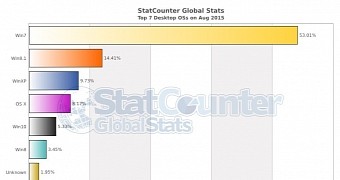Windows 10 is Microsoft's newest, hottest, and most important product on the market these days and now that more than one month has passed since its launch, we can finally have a look at how the new operating system performed in its first days on the market.
Data provided by StatCounter for August 2015 show that Windows 10 adoption went really well, although we're pretty sure that Microsoft expects even better figures, especially given the free upgrade offer that's available for those on Windows 7 and 8.1.
Right now, Windows 7 continues to be the leading operating system on the desktop in terms of market share with 53.01 percent, followed by Windows 8.1 with 14.41 percent. Windows XP is third with 9.73 percent, while Mac OS X is fourth with 8.17 percent. Windows 10 comes next with 5.33 percent, followed by Windows 8 with 3.45 percent.
More users than Windows 8
Just by looking at these figures, it becomes obvious that Windows 10 still has a very long way to go in order to compete with Windows 7 and 8.1.
While both are very likely to lose more users in the coming weeks, especially as the Windows 10 upgrade becomes available to more PCs across the world, there's no doubt that it'll be nearly impossible to dethrone Windows 7 before it reaches EOL.
Microsoft's CEO Satya Nadella said that upgrading Windows 7 and 8.1 users to Windows 10 is a priority for the Windows 10 effort and by doing this, the company can shoot two birds with one stone.
First, it can bring more users to Windows 10 and reach its goal of bringing the new OS on 1 billion devices by 2017. And second, it can avoid another Windows XP moment when Windows 7 reaches end of support in January 2020 and make sure that the world is prepared for the transition to an operating system that still receives support.
Windows 7 is, at least for the moment, the preferred option for quite a lot of users, despite the arrival of Windows 10 and the free upgrade offer, which should make Microsoft's executives wonder if there's indeed something wrong with the new OS and figure out how to fix it.

 14 DAY TRIAL //
14 DAY TRIAL //